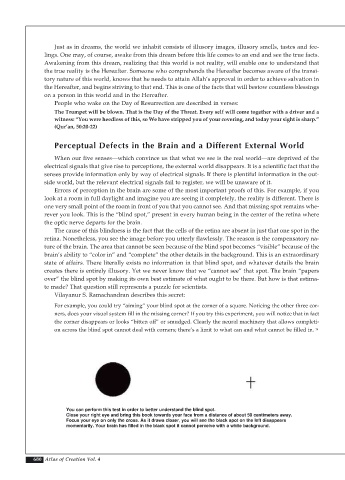Page 682 - Atlas of Creation Volume 4
P. 682
Just as in dreams, the world we inhabit consists of illusory images, illusory smells, tastes and fee-
lings. One may, of course, awake from this dream before this life comes to an end and see the true facts.
Awakening from this dream, realizing that this world is not reality, will enable one to understand that
the true reality is the Hereafter. Someone who comprehends the Hereafter becomes aware of the transi-
tory nature of this world, knows that he needs to attain Allah’s approval in order to achieve salvation in
the Hereafter, and begins striving to that end. This is one of the facts that will bestow countless blessings
on a person in this world and in the Hereafter.
People who wake on the Day of Resurrection are described in verses:
The Trumpet will be blown. That is the Day of the Threat. Every self will come together with a driver and a
witness: “You were heedless of this, so We have stripped you of your covering, and today your sight is sharp.”
(Qur’an, 50:20-22)
Perceptual Defects in the Brain and a Different External World
When our five senses—which convince us that what we see is the real world—are deprived of the
electrical signals that give rise to perceptions, the external world disappears. It is a scientific fact that the
senses provide information only by way of electrical signals. If there is plentiful information in the out-
side world, but the relevant electrical signals fail to register, we will be unaware of it.
Errors of perception in the brain are some of the most important proofs of this. For example, if you
look at a room in full daylight and imagine you are seeing it completely, the reality is different. There is
one very small point of the room in front of you that you cannot see. And that missing spot remains whe-
rever you look. This is the “blind spot,” present in every human being in the center of the retina where
the optic nerve departs for the brain.
The cause of this blindness is the fact that the cells of the retina are absent in just that one spot in the
retina. Nonetheless, you see the image before you utterly flawlessly. The reason is the compensatory na-
ture of the brain. The area that cannot be seen because of the blind spot becomes “visible” because of the
brain’s ability to “color in” and “complete” the other details in the background. This is an extraordinary
state of affairs. There literally exists no information in that blind spot, and whatever details the brain
creates there is entirely illusory. Yet we never know that we “cannot see” that spot. The brain “papers
over” the blind spot by making its own best estimate of what ought to be there. But how is that estima-
te made? That question still represents a puzzle for scientists.
Vilayanur S. Ramachandran describes this secret:
For example, you could try “aiming” your blind spot at the corner of a square. Noticing the other three cor-
ners, does your visual system fill in the missing corner? If you try this experiment, you will notice that in fact
the corner disappears or looks “bitten off” or smudged. Clearly the neural machinery that allows completi-
on across the blind spot cannot deal with corners; there’s a limit to what can and what cannot be filled in. 78
You can perform this test in order to better understand the blind spot.
Close your right eye and bring this book towards your face from a distance of about 50 centimeters away.
Focus your eye on only the cross. As it draws closer, you will see the black spot on the left disappears
momentarily. Your brain has filled in the black spot it cannot perceive with a white background.
680 Atlas of Creation Vol. 4

